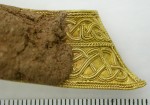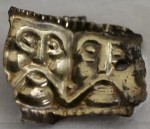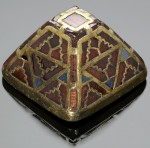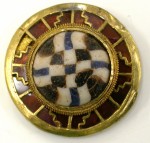 The 4,000 Anglo-Saxon pieces of gold, silver and garnet weapons fittings discovered in Staffordshire field in 2009 and in a 2012 follow-up excavation impressed with the exceptional quality of workmanship even when they were still encrusted with soil. The cleaning process has revealed metalwork and gemwork of such sophistication experts aren’t even sure how it was accomplished. Because the pieces were damaged when they were stripped from their original weapons, conservators have had a unique chance to examine construction features that are invisible in complete pieces like those discovered at Sutton Hoo or other burial sites.
The 4,000 Anglo-Saxon pieces of gold, silver and garnet weapons fittings discovered in Staffordshire field in 2009 and in a 2012 follow-up excavation impressed with the exceptional quality of workmanship even when they were still encrusted with soil. The cleaning process has revealed metalwork and gemwork of such sophistication experts aren’t even sure how it was accomplished. Because the pieces were damaged when they were stripped from their original weapons, conservators have had a unique chance to examine construction features that are invisible in complete pieces like those discovered at Sutton Hoo or other burial sites.
 Conserving intricately decorated gold artifacts requires the use of special tools. The scalpels and microdrills in the standard conservator toolbox are too dangerous to use with soft, malleable gold. They could scratch or gouge the surface. Instead, the Staffordshire Hoard conservators are using thorns, natural thorns like off a bush. They have sharp points for getting between tiny beads and edges, but they bend under pressure and don’t scratch the surface of the gold, glass or gem insets.
Conserving intricately decorated gold artifacts requires the use of special tools. The scalpels and microdrills in the standard conservator toolbox are too dangerous to use with soft, malleable gold. They could scratch or gouge the surface. Instead, the Staffordshire Hoard conservators are using thorns, natural thorns like off a bush. They have sharp points for getting between tiny beads and edges, but they bend under pressure and don’t scratch the surface of the gold, glass or gem insets.
This video from the Birmingham Museum and Art Gallery, co-owner of the hoard along with the Potteries Museum & Art Gallery, shows a conservator cleaning the top of a sword pyramid and a fragment of silver foil stamped with two male faces. You can see the thorn held in a pin vice scrape away the dirt. Then the surface is wiped with a cotton swab dampened with industrial methylated spirit. Soft brushes and air puffers gently remove the loosened soil.
[youtube=http://youtu.be/-Vuy9wZJpgA&w=430]
 The video at the bottom of this page shows the thorn deployed in cleaning the gold filigree of a damaged hilt plate, but that’s one of the simplest filigree designs. Conservation of the hoard has found a great many incredibly tiny, incredibly detailed filigree patterns. This blog entry from a jeweler covers just a few of the techniques the Anglo-Saxon craftsmen used to produce wirework so fine that we need microphotography to fully explore today. This blog entry describes some of the patterns — linear, spiral, zoomorphic, etc. — in the Staffordshire filigree pieces.
The video at the bottom of this page shows the thorn deployed in cleaning the gold filigree of a damaged hilt plate, but that’s one of the simplest filigree designs. Conservation of the hoard has found a great many incredibly tiny, incredibly detailed filigree patterns. This blog entry from a jeweler covers just a few of the techniques the Anglo-Saxon craftsmen used to produce wirework so fine that we need microphotography to fully explore today. This blog entry describes some of the patterns — linear, spiral, zoomorphic, etc. — in the Staffordshire filigree pieces.
 One of the most breathtaking examples of filigree is the stylized seahorse mount. Those spirals are so minute, three of them are almost as long as a grain of rice.
One of the most breathtaking examples of filigree is the stylized seahorse mount. Those spirals are so minute, three of them are almost as long as a grain of rice.
The garnet cloisonné has proven to hold hidden depths revealed by conservation as well. Like all cloisonné, it was made by creating a cell (called a cloison) out of gold wires. The cells were backed with gold foil and filled primarily with garnets. Today cloisonné is filled with vitreous enamel which is powdered before it’s fired, but the Anglo-Saxon jewelers had a much more difficult task because they had to cut the garnets into small, thin shapes that precisely fit the cloisons. Garnets are  hard gemstones and probably had to be ground to shape, using what tools we do not know. We do know that missing garnets were replaced by red glass. Blue glass insets have also been found as have opaque glass checkerboard or millefiori designs that experts believe are recycled Roman pieces.
hard gemstones and probably had to be ground to shape, using what tools we do not know. We do know that missing garnets were replaced by red glass. Blue glass insets have also been found as have opaque glass checkerboard or millefiori designs that experts believe are recycled Roman pieces.
The foil behind the garnets give the gems an added shine boost, and it may give historians a boost into a new understanding of Anglo-Saxon schools of metalwork. So far conservators have identified four distinct gold foil designs. If they can be compared to artifacts discovered in other locations, it may be possible to group them by workshop or regional style.
 This blog entry describes the conservation of two cloisonné objects. You can see in the microphotographs miniscule marks left during the stripping of the fittings and during the initial workmanship. Tiny troughs incised in the gold outline where the cloison walls once were, troughs just a quarter of a millimeter thick which is thinner than a lot of cloisonné produced today.
This blog entry describes the conservation of two cloisonné objects. You can see in the microphotographs miniscule marks left during the stripping of the fittings and during the initial workmanship. Tiny troughs incised in the gold outline where the cloison walls once were, troughs just a quarter of a millimeter thick which is thinner than a lot of cloisonné produced today.
Bookmark the Staffordshire Hoard Conservation & Research blog now, and say goodbye to the rest of your weekend because every entry is fascinating. Enhance your reading with the swooningly gorgeous images on the Hoard Flickr page.